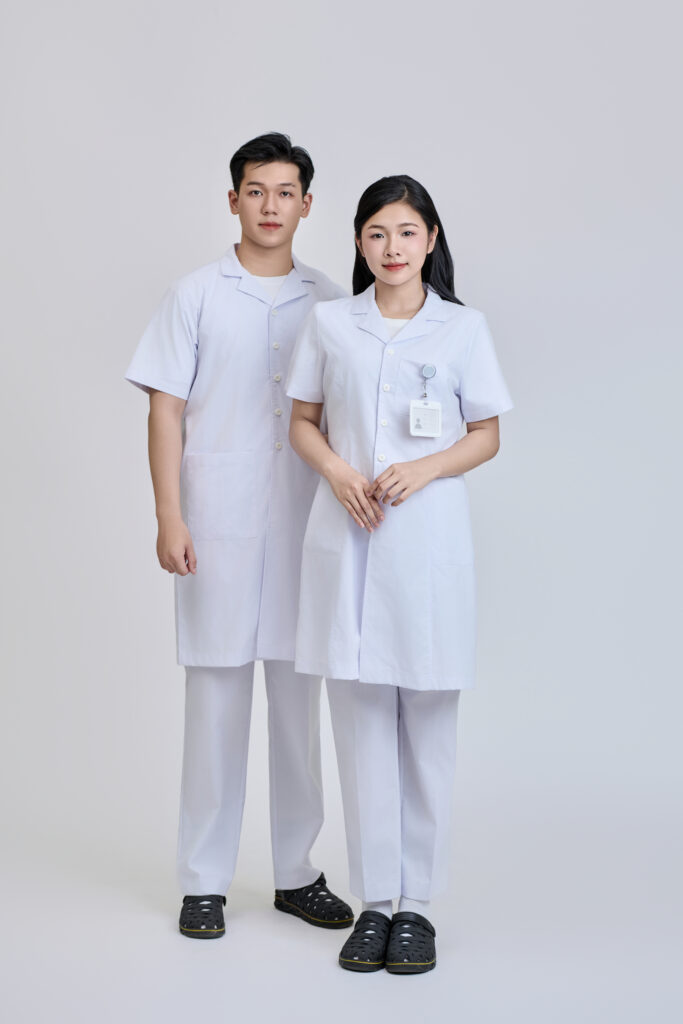1. What is a Doctor’s Blouse?
A doctor’s blouse is the distinctive uniform worn by doctors, physicians, and medical staff in hospitals and clinics. It is not just a simple piece of clothing but a representation of professionalism, credibility, and responsibility in the medical field.
The doctor’s blouse has a simple yet significant design, helping to distinguish healthcare workers from patients and ensuring clear identification in medical environments. Furthermore, it provides protection for the wearer against harmful agents such as bacteria, chemicals, blood, and bodily fluids.

You may also be interested in: Standard Medical Uniforms Approved by the Ministry of Health
2. History and Significance of the Doctor’s Blouse in Medicine
Originally, the white coat was introduced to emphasize cleanliness and sterility in medical settings. White symbolizes purity, transparency, and fosters trust among patients. However, before the 19th century, doctors often wore dark-colored coats. Over time, white coats became more common as they better represented hygiene and scientific precision.
Today, besides the traditional white, doctor’s blouses come in various colors depending on the specialty and workplace. For example, surgeons typically wear green or blue scrubs because these colors help reduce eye strain during procedures.
3. Common Types of Doctor’s Blouses
a. Long-Sleeved Doctor’s Blouse
This type is commonly used in hospitals and clinics. Long sleeves offer better protection against dirt, chemicals, and direct contact with bacteria. Additionally, they help keep doctors warm in air-conditioned workplaces.
b. Short-Sleeved Doctor’s Blouse
Ideal for high-intensity work environments that require agility, such as emergency rooms and private clinics. Short sleeves allow for easier movement and better ventilation, making them more comfortable during long working hours.
c. Colored Doctor’s Blouses
Beyond the traditional white, various medical departments such as pediatrics, surgery, and obstetrics use colored blouses like blue, green, or pink to create a more approachable and calming atmosphere. In pediatric hospitals, bright-colored blouses help reduce anxiety and fear in children.
d. Antibacterial Doctor’s Blouse
A modern version made from antimicrobial fabric that prevents the adhesion of bacteria and viruses. This type provides better protection for healthcare professionals dealing with highly contagious patients.

4. How to Choose the Right Doctor’s Blouse
a. Material
-
Cotton: Breathable, sweat-absorbent, and suitable for busy medical environments.
-
Khaki: Durable and sturdy, often used in high-demand workplaces.
-
Polyester: Wrinkle-resistant, easy to wash, and more durable than cotton.
b. Fit and Design
-
Loose-fit blouse: Suitable for all body types and allows for easy movement.
-
Slim-fit blouse: Provides a more professional and tailored look.
c. Color Options
-
White: Traditional and suitable for most medical departments.
-
Green/Blue: Typically worn in operating rooms and surgical departments.
-
Pink/Pastel colors: Popular in pediatrics and obstetrics.
d. Brand Selection
Choosing reputable brands ensures product quality and durability. Some well-known brands for doctor’s blouses include Dickies, Landau, Cherokee, and trusted domestic suppliers specializing in medical apparel.
5. How to Maintain a Doctor’s Blouse

-
Wash after each use: Use warm water and antibacterial detergent to maintain hygiene.
-
Avoid strong bleach: As it can damage the fabric and cause discoloration.
-
Air-dry in mild sunlight: To eliminate bacteria and speed up drying.
-
Iron before wearing: Ensures a crisp, professional appearance.
6. Where to Buy a Reliable Doctor’s Blouse?
Today, many suppliers offer high-quality doctor’s blouses at reasonable prices. When purchasing, it is important to choose reputable retailers, ensure the product meets medical standards, and check for clear warranty policies.
Recommended Places to Buy a Doctor’s Blouse:
-
Stores specializing in medical uniforms in major cities.
-
Trusted e-commerce platforms selling medical protective clothing.
-
Official distributors of well-known medical apparel brands.
7. Current Trends in Doctor’s Blouses

-
Fashionable Blouses: Modern, youthful designs with a slim fit.
-
Blouses with Functional Pockets: Convenient for carrying small medical tools.
-
Antibacterial Blouses: Made from fabric with antimicrobial properties for enhanced protection.
-
Eco-Friendly Blouses: Produced from organic or recycled materials, promoting environmental sustainability.
Conclusion
The doctor’s blouse is more than just a uniform; it is a symbol of the medical profession, representing dedication and expertise in healthcare. Choosing the right blouse enhances comfort at work while reinforcing the professional image of medical staff. Investing in a high-quality doctor’s blouse ensures convenience, safety, and efficiency in daily medical practice.
You may also be interested in: Premium Medical Uniforms by FMF






 Tiếng Việt
Tiếng Việt

Sản phẩm
Red And Black Short-Sleeve Workwear Set
Red And Black Long-Sleeve Workwear Set
Blue And Grey Short-sleeve workwear set
BLUE+GREY LONG-SLEEVED WORKSUIT
CHARCOAL+GREY SHORT-SLEEVED WORKWEAR
CHARCOAL+GREY LONG-SLEEVED WORKWEAR
SHORT-SLEEVED REFLECTIVE GRAY WORKSUIT
LONG-SLEEVED REFLECTIVE GRAY WORKSUIT
GREY COORDINATE LONG-SLEEVED NAVY
NAVY POLO JERSEY
POLO BLUE+NAVY JERSEYS FOR MEN AND WOMEN
POLO JERSEY NAVY+WHITE MEN’S/WOMEN’S